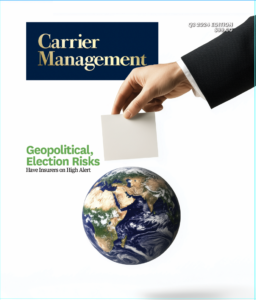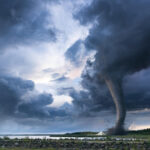Just a few weeks before Carrier Management’s third-quarter edition went to print, a shooting incident took place at a Butler, Pa., rally for former President Donald Trump’s 2024 election campaign.
The former president was injured, one spectator was killed, and two more were critically injured before the assailant was fatally shot by the U.S. Secret Service. The FBI said in a public statement that the incident was being investigated as an assassination attempt and potential domestic terrorism, with the shooter being identified as 20-year-old Thomas Matthew Crooks of Bethel Park, Pa.
“The U.S. is more polarized than ever before,” said Lucy Straker, U.S. focus group leader of political violence and deadly weapons at Beazley. She was speaking during a Carrier Management webinar, “From Ballots to Business: Election-Year Challenges for Insurers,” which took place before the shooting in Pennsylvania. “Often, you’ve got really divisive topics that lead to emotion, and that’s dividing the country. With that, you’re going to see violence fuel up.”
She said during the webinar that the U.S. is seeing an increase in what she described as “lone-wolf” attacks, which is contributing to shifting ideas about what terrorism can look like.
“I think that’s what we’re concerned with, as an insurer, is that changing face of terrorism,” she said. “It’s the everyday violence that we see across the U.S. that’s very evident, and that’s what I think our clients need to be aware of and prepare for.”
This comes as more than 160 million Americans are registered to vote in the 2024 U.S. presidential election, according to the World Economic Forum.
“Elections and transitions of power can oftentimes lead to civil unrest and increased geopolitical risk,” said Matt Westhoff, head of North American commercial property at Beazley, speaking alongside Straker during Carrier Management’s webinar prior to the Pennsylvania shooting. “We saw this in the U.S. just four years ago when we had the same two candidates running for president.”
However, while the U.S. will head to the polls on November 5, the upcoming U.S. election isn’t the only factor that could lead to heightened unrest. This will be a record-breaking year for elections globally. U.S. policy institute The Center for American Progress reported that around the world, more than two billion voters in 50 countries will go to the polls.
“We all know about the election in the U.S., but I think what a lot of people don’t know is that roughly half the world’s population will be voting this year,” Westhoff said. “I think broadly speaking, the world is a riskier place than it was four years ago. It would be rather unwise not to expect increased civil unrest and political violence. It’s one of those situations where, obviously, we hope for the best but prepare for the worst.”
 In this edition, we examine how insurers and reinsurers are preparing for ongoing global unrest and a historical election year. Insurers spoke with me about how the industry is rethinking coverage in risk areas such as strikes, riots and civil commotion, war, and cyber for the cover story, “Geopolitical, Election Risks Have Insurers on High Alert.” More content can be found online in my article, “What Role Does Insurance Play in a Politically Charged Climate?“
In this edition, we examine how insurers and reinsurers are preparing for ongoing global unrest and a historical election year. Insurers spoke with me about how the industry is rethinking coverage in risk areas such as strikes, riots and civil commotion, war, and cyber for the cover story, “Geopolitical, Election Risks Have Insurers on High Alert.” More content can be found online in my article, “What Role Does Insurance Play in a Politically Charged Climate?“
In a separate magazine article, International Editor L.S. Howard shares how insurers and reinsurers are responding to heightened risks of civil unrest with new modeling tools to calculate their probable maximum losses and help grasp this potentially costly risk.
Assistant Editor Kimberly Tallon also compiled some timeless leadership tips on the best ways for leaders to manage polarized workforces.
Finally, supplementing our magazine content is my two-part “Between The Lines” video series, “From Ballots to Business: Election-Year Challenges for Insurers.”
Stay tuned for the second installment in October, or sign up now at https://bit.ly/3SGjTxs





















 The Future of Premium Audits: Using AI Assistants to Streamline Data Collection
The Future of Premium Audits: Using AI Assistants to Streamline Data Collection  Performance Review: Why Insurers Struggle to Underwrite, Price and Reserve for Commercial Auto Risks
Performance Review: Why Insurers Struggle to Underwrite, Price and Reserve for Commercial Auto Risks  Is State Farm General Too Big to Fail? Calif. Rate Hearing Concludes
Is State Farm General Too Big to Fail? Calif. Rate Hearing Concludes  2024 Second on Record for Most Tornadoes in the U.S. in a Year
2024 Second on Record for Most Tornadoes in the U.S. in a Year 
